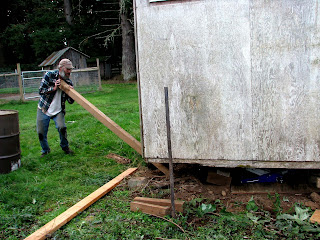Enjoy and happy Thanksgiving!
Sunday, November 27, 2011
Turkey Tale Redo
Enjoy and happy Thanksgiving!
Labels:
Gimpy McGimperson,
reluctance,
turkeys
Friday, November 18, 2011
The Running of the Chickens
Just in case anyone has been wondering what it is like to have 46 chickens free ranging around the Homestead, I just thought I'd give you little taste of the mild chaos that occurs at dinner time around here. Of course it is not a forever thing since 23 of these chickens are headed for the freezer at the end of November, so I find it funny. Not something I would want to deal with all the time though.
Mr. B adores his new task of herding the Meaty Chicks into their pen for the night.
Mrs. B pretends to not care, but surprisingly just happens to be in the right place at the right time to nudge the odd wayward chicken into the door. She is also much more determined than Mr. B when it comes to getting a chicken out of the thick brush. When Mr. B gives up on a chicken lost in the brush, I implore for Mrs. B's help. She plods into the brush and a minute later out shoots a chicken.
No one who has known Mr. B or Mrs. B all these years, would have ever suspected they had a secret talent for herding chickens. Hurting chickens, Sure! But herding? No way.
Well, they don't care what ya'll think. Tha'r Farm Dawgs now.
Tuesday, November 15, 2011
Loafing Shed 1
So, we built a pasture.
And we moved the horse in.
And now it is time to take the next step, the Loafing Shed. Horses like to loaf around. As do I, I must admit. However, when it is raining at the Homestead, I get to loaf in our cozy warm trailer. The horse gets to stand under a tree.
(OK, not entirely true. There is a paddock for him, but it is not in the pasture, and neither he nor we are big fans of him spending a lot of time in there. Muddy and boring.)
Anyway, we need to create a shelter in the pasture for the horse, soon to be horses. Hence the Loafing Shed.
We are putting the posts on concrete, which needs time to set up before we can put weight on it. Since we won't be working over Thanksgiving, doing the footings now will give them time to set up.
First step was to dig the holes. I cordoned off that part of the pasture, using half of the round pen. We don't want the very inquisitive mustang getting in there. The spot is just across from the barn, and at the crest of a small slope: both key considerations in choosing the site.Digging holes is one of my primary contributions to these projects. (I also specialize in holding things, getting things and being dead weight.)
I got all fancy on the hole digging, using the Pythagorean Theorem to determine where the second row of holes should be dug. I honestly think this is the only instance in which high school algebra has actually served me well. My posts are on 9' centers, so my a2 and b2 are both 81, which makes my c2 162, and its square root 12.72. I tied some baling twine together, and put a knot at 12.72-ish feet and triangulated that with 9' on the tape measure. That told me where to dig my hole at a right angle to the other. (Whew, math!)
Mr B was there as usual, offering moral support.
Holes dug, the next step was to pull Hank off Phoebe's Art Shack project. In addition to being an excellent carpenter and collaborator, he is also a wiz at concrete. He has worked on Bonneville Dam, and on the 7 story refrigerator at the Tillamook Creamery.
So putting in our posts would be no problem.
We started by bending rebar to give the concrete a little more to hold on to.
I sprung for deluxe brackets; the wind can blow pretty good up here, and since we are not burying the posts in the concrete, I wanted the saddles to be really beefy. (Phoebe has long opposed putting posts in concrete, and with a little googlin' I understand why. Check it out if you are curious.)
hank put a pair of 12' 2X4 together to get a nice straight line to center the brackets over the holes, and keep them in place when the concrete is poured and cures.
He marked the boards where each saddle would hang.
We held the boards in place with stakes, and marked them so we could move the boards and get them back in the right spots.

Hank likes to mix a shovel full of Portland Cement into each bag of concrete. Says it sets up stronger and cures faster.

Mixed it in the wheelbarrow, then dumped or shoveled it into the holes.


And voila, nice concrete footing for our saddles. We will let them sit as is for 10 days or so. Then the boards come out, and we are ready to build the structure.

After all that work, it was time for a cup of Phoebe's home roasted coffee.
Oh, and one last thing: What a crazy beautiful day for mid-November!
Labels:
construction,
fence,
horses,
how to,
loafing shed,
pasture
Friday, November 11, 2011
Notes from the Faraway
It's June here, folks. The girl, not the month.
My folks haven't mentioned it, but I'm not really around the farm anymore. In fact, I'm an ocean and a couple of continents away, in St. Petersburg, Russia, where it looks like this.

What on earth could I possibly say about homesteading? After all, I'm in the middle of a huge city. Well, there just happens to be a wealth of agricultural riches in the Ethnographic Museum here. I took a few pictures just for mom and dad, and they were so enamored that they asked me to show them to you guys!
First, let's meet our hero, the Russian serf. He looked like this:
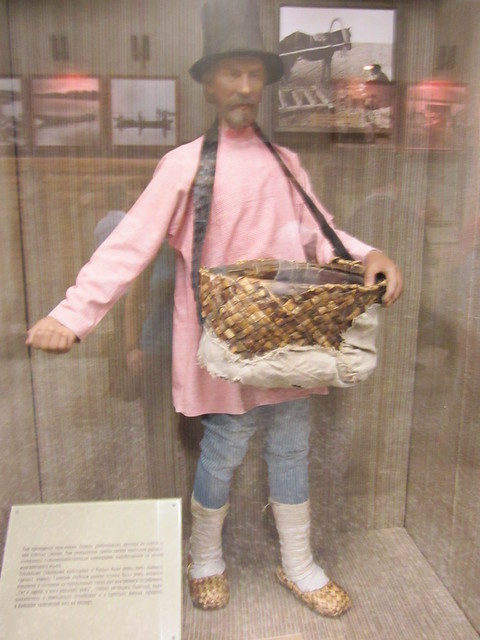
He lived in a wooden house that was covered in carvings he did himself.
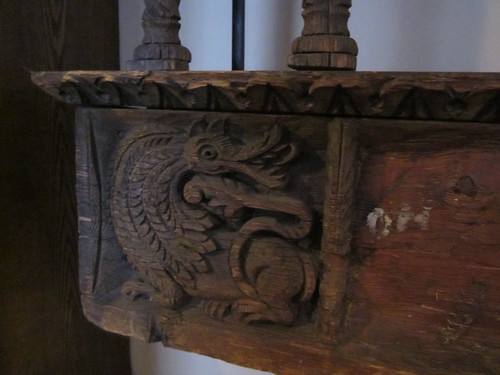
He spent most of his life squeezing a living out of the unforgiving earth of Russia. His greatest helper (besides his wife, who almost never gets mentioned except when she has babies) was a horse, who pulled a plow while wearing these lovely collars.
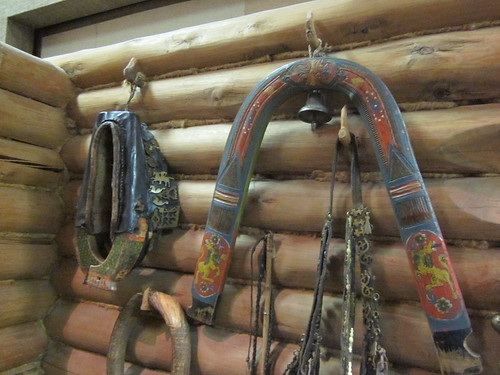
When he wanted to eat something besides wild berries, rye, and maybe a little milk, he turned to honey from the bees he kept in a stump hive.

He harvested the honey with hand-carved wooden tools.
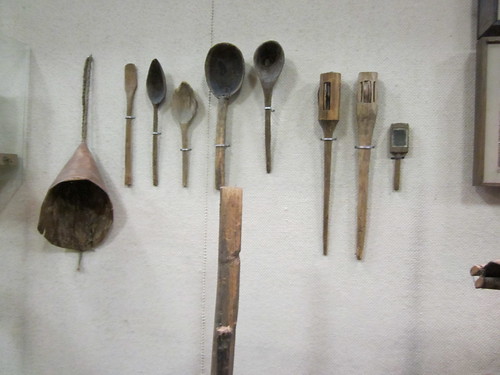
Farming is dirty, dirty work, and I doubt that little-mentioned wife would be very happy if everyone tromped into the house with ridiculously filthy hands. A nasty bucket of dirty water is not the nicest way to wash your hands, so the ingenious serfs came up with this solution:
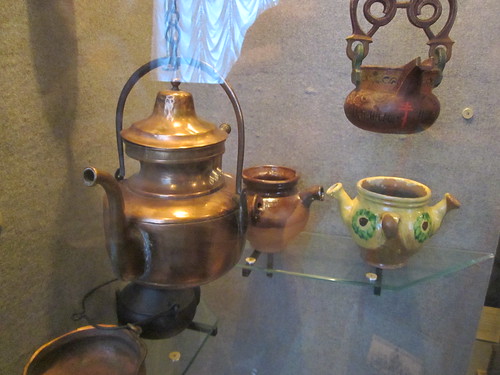
No, those aren't teapots. They're handwashers. The genius of them is that you can just hang them up and then tip out water to wash your hands, without having to get muck all over everything or use water that the rest of the household has already scrubbed in. I have a feeling they probably hung them up somewhere warm, as well, though I can't actually prove that.
The most interesting part of the tour was this guy.
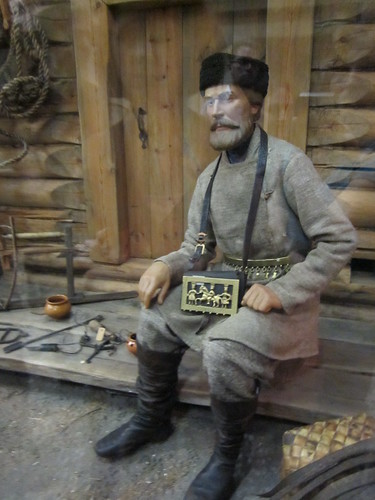
The astute among you will notice several things about this guy. First off- and dad noticed this right away, which I'm very proud of him for- he's wearing leather boots. If you remember from the first photo, Mr. Average Serf wore shoes he wove himself out of birchbark. They had to be replaced every couple of weeks and stuffed with rags in the winter. Leather, for a family which usually had one cow if they were lucky, would have been an unbelievable luxury. Also, he's wearing a brass belt with little charms all around it that jingle as he walks, and he carries a tool bag with a little detailed scene on it.
I know it's not super visible in the photo, but that little scene is a horse with a man riding it, a man leading it, and a man watching it. The bag and belt are the signs of his profession: he's a horse healer.
He was just a normal serf, but with special talents for driving away demons, appeasing the local gods, and satisfying the wants of your domestic goblins, all of which were very necessary for the healing of your beloved horse and cow, on which the life of Mr. Serf and all his loved ones depended. After harvest every year he would suit up and travel from village to village, trying to smoke, bleed, or chant away the illnesses that were ruining families.
He had one other duty, too. A very serious one. He was a roaming butcher.
It seems that even the toughest, manliest, bravest serf couldn't always bear to slaughter livestock that he had raised. Those pigs, cows, and horses could be like family, and taking a knife to them was unthinkable. Just as unthinkable, however, was forcing your family to starve through the winter. So, for a small fee, this detached stranger would come and do the deed for you.
I found this very interesting. It seems like today there's stigma in not being able to butcher your own livestock, even though it's not fiscally or morally harmful to pay someone else to do it. My parents use a butcher down the way for their chickens, who is both affordable and humane, and saves them a long, bloody, feathery day. But surely, if they were real farmers, they'd do it themselves?
It seems not. Hundreds of years ago, farmers were still making the mistake of naming their pigs Betsy and scratching their backs. And hundreds of years ago, the manliest of men traveled around, making sure that life could go on- at least for the farmers.
My folks haven't mentioned it, but I'm not really around the farm anymore. In fact, I'm an ocean and a couple of continents away, in St. Petersburg, Russia, where it looks like this.

What on earth could I possibly say about homesteading? After all, I'm in the middle of a huge city. Well, there just happens to be a wealth of agricultural riches in the Ethnographic Museum here. I took a few pictures just for mom and dad, and they were so enamored that they asked me to show them to you guys!
First, let's meet our hero, the Russian serf. He looked like this:

He lived in a wooden house that was covered in carvings he did himself.

He spent most of his life squeezing a living out of the unforgiving earth of Russia. His greatest helper (besides his wife, who almost never gets mentioned except when she has babies) was a horse, who pulled a plow while wearing these lovely collars.

When he wanted to eat something besides wild berries, rye, and maybe a little milk, he turned to honey from the bees he kept in a stump hive.

He harvested the honey with hand-carved wooden tools.

Farming is dirty, dirty work, and I doubt that little-mentioned wife would be very happy if everyone tromped into the house with ridiculously filthy hands. A nasty bucket of dirty water is not the nicest way to wash your hands, so the ingenious serfs came up with this solution:

No, those aren't teapots. They're handwashers. The genius of them is that you can just hang them up and then tip out water to wash your hands, without having to get muck all over everything or use water that the rest of the household has already scrubbed in. I have a feeling they probably hung them up somewhere warm, as well, though I can't actually prove that.
The most interesting part of the tour was this guy.

The astute among you will notice several things about this guy. First off- and dad noticed this right away, which I'm very proud of him for- he's wearing leather boots. If you remember from the first photo, Mr. Average Serf wore shoes he wove himself out of birchbark. They had to be replaced every couple of weeks and stuffed with rags in the winter. Leather, for a family which usually had one cow if they were lucky, would have been an unbelievable luxury. Also, he's wearing a brass belt with little charms all around it that jingle as he walks, and he carries a tool bag with a little detailed scene on it.
I know it's not super visible in the photo, but that little scene is a horse with a man riding it, a man leading it, and a man watching it. The bag and belt are the signs of his profession: he's a horse healer.
He was just a normal serf, but with special talents for driving away demons, appeasing the local gods, and satisfying the wants of your domestic goblins, all of which were very necessary for the healing of your beloved horse and cow, on which the life of Mr. Serf and all his loved ones depended. After harvest every year he would suit up and travel from village to village, trying to smoke, bleed, or chant away the illnesses that were ruining families.
He had one other duty, too. A very serious one. He was a roaming butcher.
It seems that even the toughest, manliest, bravest serf couldn't always bear to slaughter livestock that he had raised. Those pigs, cows, and horses could be like family, and taking a knife to them was unthinkable. Just as unthinkable, however, was forcing your family to starve through the winter. So, for a small fee, this detached stranger would come and do the deed for you.
I found this very interesting. It seems like today there's stigma in not being able to butcher your own livestock, even though it's not fiscally or morally harmful to pay someone else to do it. My parents use a butcher down the way for their chickens, who is both affordable and humane, and saves them a long, bloody, feathery day. But surely, if they were real farmers, they'd do it themselves?
It seems not. Hundreds of years ago, farmers were still making the mistake of naming their pigs Betsy and scratching their backs. And hundreds of years ago, the manliest of men traveled around, making sure that life could go on- at least for the farmers.
Saturday, November 5, 2011
The Guest House Begins
Our amazing carpenter and friend Hank showed up the other day and suddenly we are at work! He fits us in, between other, better paying jobs and so we are thrilled when he calls from the end of the driveway and asks "Is it Coffee Time?" because he knows it's always coffee time here at the Homestead when he arrives. We walk around after coffee and show off all the things we have done like little kids when their parent comes to visit their school classroom. Then we commence work on whatever and wherever we left off.
This is the same guy who helped do that amazing rescue job on the Hay House. I was teasing him today because he does not have or use a computer and he will be featured prominently in this post.
I could say anything and he wouldn't know.
But really the only things I want to say about him are good things. Like what a great boss he is. He wasn't a friend when he came to work with us three years ago, but he is now. We really enjoy his kind and down to earth attitude and his easy laugh. He has, over the last three years, taught Buck and I so much. He is so patient and will talk you through all kinds of building tricks, without ever getting impatient or grabbing it away from you to do it himself.
He's like a carpenter Buddhist. I have decided to start calling him Handy Hank. He'll hate that.
Remember that Canned Ham 1958 Oasis Buck and I bought this summer? Well, this months project is a "Guest House" in the loosest sense of the term.
Although a guest house seems like a strange choice in the Homestead trajectory, the thinking behind getting started on the guest house is really a practical decision, not really a luxury.
Handy Hank lives over an hour away and if we had a place for him to stay during the work week, he would save a lot of time and gas money and we could move ahead faster on bigger projects, like a house to live in, instead of a trailer.
We also have another good friend who has been trading places with Buck and I as the Homestead Captain, back and forth, back and forth with us over the last 2 years. It frees Buck and I up so we can work jobs and go on a vacation now and then. If we had two places to stay here at the Homestead, we could more easily decide whether to come or go, instead of taking turns living in the same trailer.
And we could, maybe, have "guests" now and then!
O.K. On to the "Art Shack" process. That is it's name, "Art Shack"... It's a long story, best told in person. Anyway, remember the post when Buck took out all those blackberries? Well after he took out even more of them this little building, which was a granary most recently in it's long history, was in the middle of that thorny mountain.
I have a vision that Buck is being a good sport about and so we are going full speed ahead. I wanted to combine our Oasis trailer and the old granary shack to create a little getaway, the trailer being a kitchen, dining room and kids bedroom and the shack being the living room by day with futon couch and bedroom by night, all joined together with a nice big deck with a view.
My plan hinged on the hare brained idea that the granary should be turned 15 degrees South so it would face the very nicest view on the property and maximize the sun exposure for the solar panels which I am putting on the roof.
The Art Shack will be mostly off the grid except it will benefit from the existing well water which has an electric pump. The Art Shack will have a propane heater and a tiny propane tankless hot water heater and the trailer of coarse has a few 12v lights, a propane oven and stove and propane light over the dining table.
I am setting up three 15 watt solar panels to trickle charge 2 RV batteries which will then power low watt RV lights in the shack and trailer and hopefully will power some music and charge a lap top.
Handy Hank didn't even blink an eye when I told him what I wanted to do with the Oasis and the Shack. He generally says "Oh, really?" laughs and then proceeds to cogitate a way to do what we dreamed up. That's what he did this time too.
He showed up the next day with two floor jacks. Under Hanks' direction, we jacked up the shack,
We jacked it up again (keeping several blocks built up under the building so that if it slipped off the jacks it would settle back down on the blocks) and let the wheels of the jacks slowly roll the building in the right direction while Hank used a 4x4 as a lever to push it slowly around.

Simple, huh? This is something Buck and I would have NEVER dreamed of doing on our own. Even if we had had the smarts to invent this method, I would have been scared to death to try it.
Now that it was in it's permanent place, we helped replace and beef up the beams underneath and around the rim. There had been more than a little Wood Pecker and Carpenter Ant activity.
 |
| I don't get worried anymore if I see this much daylight coming through a wall, that says something right there. |
When Buck was inside vacuuming out the ants from the walls I could hear him yelling over the shop vac "It's like a HORROR MOVIE!" I laughed until I cried, but I didn't go in! They dumped the vacuum out for the chickens and they went crazy over them there ants.
It went just as Hank planned it and now the 8x12 building is perfectly placed to catch the ultimate view and catch 7 hours of sun. We towed the Oasis up next to it and leveled it up with jack stands.
Buck helped dig and place all new post and piers under the shack.
Today we put in a "new" salvaged door and one of three salvaged windows.
In the next few weeks we will be adding two more windows on the East wall (one where the old door was), wire, insulate, drywall and if we don't run out of time, build a deck that joins the "shack" and trailer. It may look filthy now, it is and so are we, but it is going to be so cute when we are done!
And this will be the view from the new window:
and the deck.
Labels:
Art Shack,
construction,
Oasis
Subscribe to:
Comments (Atom)




























